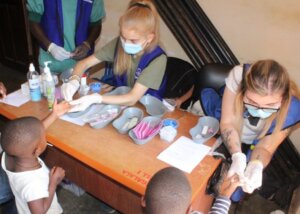Here is our third blog post from Julie one of the Childhood Studies Lecturers. We hope you enjoy reading this and will provide your own thoughts and memories in the comments.
When a two-year-old child begins nursery or a preschool setting this is what we call a transitional period, and the term is used to describe a fluid period of change which includes a social process of discontinuity, as they physically move from one state to another such as from their home to setting (Webb, Knight and Bush, 2017). During the transition, the child experiences significant adjustments, specifically psychological and cultural ones that then influence and impact their cognitive, social, and emotional skills (Vogler, Crivello and Woodhead, 2008). Although it is important to know that how a practitioner attunes to the child during their transition this can impact their sense of having agency. This is because they are actually active agents within the process of their transition, and they should have the right to be respected and supported, and practitioners should do this by taking into account the child’s past, current and ongoing experiences (Uprichard, 2008).
As the child transitions from home to early education, their readiness for this change in daily routine impacts through the ecological systems (Bronfenbrenner, 1979; Piaget, 1959), which can then affect how they are understood by the practitioner and also their parents (Vygotsky, 1978). The transition from home to early education is known as a vertical transition in critical literature, and this is defined as an ‘upward shift’ (Vogler, Crivello and Woodhead, 2008, p.2). This upward shift is described by Van Gennep (2010) as a rite of passage that is made up of three specific stages: pre-liminal, liminal, and post-liminal. You may also be interested to know that there are other transitional processes children experience that have received lesser attention than the dominant educational ones such as the physical moves from class to class or school to school. These lesser focused upon ones include skills such as learning and emotional literacy, yet all transitions ‘crucially and continuously shape children’s experiences and…central in shaping children’s life trajectories’ (Vogler, Crivello and Woodhead, 2008, p.2).
The pre-liminal stage is the preparation stage and can be linked to sociocultural theory (Vygotsky, 1978). In this stage of the transition parents, caregivers or practitioners should aim to prepare the child to separate from their dominant environment, which in most cases is their home. This according to literature and theory should be done through play and communication to explain the changes that are going to happen in their daily routine, this can then act as a reference guide for the child and scaffold the child’s expectations and experiences through the transition (Woods and Pollard, 1988). If I analyse this I begin to think that this suggests parents and practitioners should be competent in preparing children for a change, with the capacity and knowledge to explain the nature of the changes in a way the child will understand such as by using their interests to stimulate them. It is at this point I begin to think about how the practitioner might include the child’s interest to smooth the transition and respect them as an active agent. This is a key point for any potential or practicing practitioners as Dockett and Perry (2004) argued there can sometimes be a disconnect between the home and the setting for many parents and children, which directly impacts on the child’s sense of security, well-being, and belonging during the process of their transition.
The liminal stage is linked to the child’s actual physical movement between their home and the school environment, and their integration in the new setting (Van Gennep, 2010). This is when the child might be what is known as becoming school-ready. The liminal stage is heavily linked to Piaget’s (1959) theoretical arguments on child development and particularly what he described as states of equilibrium and disequilibrium. Although this particular development discourse, specifically his notion of readiness at particular ages, has received critique in literature (Reflected in Scott-Little, Kagan and Frelow, 2006) it remains useful for students and practitioners as it underpins elements of our statutory frameworks. During the liminal stage we know that the child develops their specific schematic play as a way to represent their current understanding of the change they are experiencing, this is because they are beginning to assimilate within their new world, or their disequilibria. They will continue using their schema until they achieve what is known as re-equilibrium within their setting (Lourenco and Machado, 1996). The child’s transformation between these two things is rooted in a progressive, psychological shift that creates a personal and crucial reference point that could have been instigated initially by the parent or the practitioner in the preparation stage (Vogler, Crivello and Woodhead, 2008).
If we can successfully facilitate the inclusion of the child in the first two stages of the transition at home and in practice, this can have a significant impact on achieving what is known as the post-liminal stage. Lam and Pollard (2006) stated this change is reached when the child has successfully adapted to the new environment and their identity has changed to reflect their new position, such as an active learner. So, you can see how this also can be linked to how a child develops their identity and all the factors that contribute to this. Literature also tells us that reaching the post-liminal stage is also known as a border crossing within a rite of passage (Vogler, Crivello and Woodhead, 2008). This means the child can shift and adapt their identity between two domains to competently socially actor several roles, so the child is no longer what is called ‘betwixt and between’ (Turner, 1995, p.95).
Conroy (2004) argued achieving this status in education relies on the practitioner’s input and the affordances provided for the child. For example, the role of the practitioner would be to facilitate a space for the child to develop their critical thinking to challenge their daily experiences, achieved by creating or providing experiences that allow for their autonomy to be valued. This would mean allowing for opportunities to agree or disagree with what is happening. This is known as taking a process over outcome approach which places educational experiences as the most appropriate way of learning (Bruner, 1961). Affording experiences to the child can be explained by using the theory of affordance, but it can also be linked to Bottrell’s (2018) discussions on environment. This would then be explored further by considering what is or is not an enabling environment.
Next week I want to pick up on the teddy in the picture we were permitted to share last week and link that to theory too. Or do you have other suggestions for a topic you would like us to explore with you? If you do please post any comments or reflections below!
Thank you for reading, Julie.




